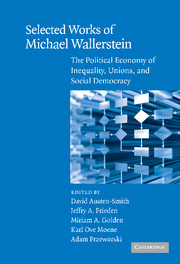 Selected Works of Michael Wallerstein
Selected Works of Michael Wallerstein Published online by Cambridge University Press: 27 January 2010
Introduction
There are large differences in the distribution of wages and salaries across advanced industrial societies and, in some countries, significant change over time in the recent past. In the United States, a worker who somehow managed to rise from the 10th decile of the wage distribution to the 90th decile would have received a pretax wage gain of 440 percent in 1990. To accomplish the same feat in 1980 would have taken a wage gain of only 380 percent. Both figures are in sharp contrast to the 98 percent increase that a Norwegian worker would obtain in going from the 10th to the 90th decile in the wage distribution in 1990. While countries may differ even more in the distribution of income from capital or transfer payments, the preponderance of labor earnings in total income is such that differences in the distribution of wages and salaries account for most of the cross-national variation in measures of the distribution of income among the nonelderly.
In the United States, the growth of wage inequality since 1980 blunted the usual impact of economic growth on poverty alleviation. The prolonged economic expansion that began in 1982 had little effect on the proportion of the US population with incomes below the poverty line until the mid 1990s, in sharp contrast to the significant declines in poverty that occurred during earlier economic expansions in the postwar period (Blank 1997).
To save this book to your Kindle, first ensure [email protected] is added to your Approved Personal Document E-mail List under your Personal Document Settings on the Manage Your Content and Devices page of your Amazon account. Then enter the ‘name’ part of your Kindle email address below. Find out more about saving to your Kindle.
Note you can select to save to either the @free.kindle.com or @kindle.com variations. ‘@free.kindle.com’ emails are free but can only be saved to your device when it is connected to wi-fi. ‘@kindle.com’ emails can be delivered even when you are not connected to wi-fi, but note that service fees apply.
Find out more about the Kindle Personal Document Service.
To save content items to your account, please confirm that you agree to abide by our usage policies. If this is the first time you use this feature, you will be asked to authorise Cambridge Core to connect with your account. Find out more about saving content to Dropbox.
To save content items to your account, please confirm that you agree to abide by our usage policies. If this is the first time you use this feature, you will be asked to authorise Cambridge Core to connect with your account. Find out more about saving content to Google Drive.